Arizona Vegetable & Fruit Gardening
For The Arizona Desert Environment
Pictures, Photos, Images
Descriptions, & Reviews.
George & Eve Delange
Arizona Soil Tilling, & Cultivation.

|
 |
| Arizona Soil Tilling & Cultivation. Yuma, Arizona. January 21, 2016. |
|---|
We Buy Our Hard To Find Fruit Trees For Yarnell Arizona At Nature Hills Nursery.
We Have Several Nice Fruit Trees Growing In Yarnell, Arizona.
They Will Do Well In Other Similar Elevations In Arizona. ie.. Prescott, Cottonwood, Camp Verde, Sedona.
Cameo & Fuji Apples! Yummm! Click The Nature Hills Nursery Link To View.



We wish to thank Wikipedia, the free encyclopedia for some of the information on our web pages. We share images and information with Wikipedia. We also donate to Wikipedia, & would suggest that others do the same. You may recall that we have mentioned that our family has been active in Arizona agriculture since about the same time that Arizona became a state. One relative, Floyd Hawkins was the President of the Arizona Farm Bureau for 17 years. So we have a unique knowledge of farming in Arizona to write about on this page. So, we are going to discuss the tilling of garden soil by including some information about the tilling, & cultivation of garden soil; from the viewpoint of the commercial grower. The commercial grower makes his or her living by growing food. Some of the things they do in order to grow their crops can be used by the gardener at a much smaller scale, but they will benefit the home gardener. Soil tilling, & cultivation is one of those subjects. The information that we are placing upon this page is specifically written for the growing of lettuce, and other crops similar to lettuce, but generally speaking, the information would apply to just about any garden, or field crop. You will need to make some slight adjustments for the growing of other crops. For example adjustments such as the depth of the soil. Please note as you read this page. We are writing mainly about commercial production, but the home gardener can use this information to till their home garden, but they will simply use normal gardening equipment to do the tilling instead of the expensive commercial equipment. To prepare this web page, we went to Yuma, Arizona to see how it is being done. The reason is because Yuma County is "America�s Winter Vegetable Capital." Yuma County is the winter lettuce capital of the world, supplying a whopping 90% of the nation�s leafy vegetables between November and March. Another reason to visit Yuma is that approximately 45,000 - 55,000 acres of lettuce are grown in Arizona, 95% of which is produced in the lower Colorado River, and Gila River Valleys of Yuma County where the elevation is below 100 feet. Here is another little known fact about Yuma County. Because of their outstanding vegetable production, a large Agritourism industry has developed in the Yuma Area. They have tours of lettuce, & date farms; as well as culinary classes. We have to admit that we spent two days just touring the various farms & we wish we could have spent more time. It was interesting and exciting to do. It brought back a lot of fond memories about our own farming experiences. For example, George remembered that when he was about 6 years old, he drove one of the tractors, & fed the cows on his grandfathers farm. That would probably be child abuse in these days, but it was just plain fun in those days! We can learn a lot from the farmers in Yuma! So, here we will go! Let's learn about tilling, & cultivation. Note, if you have not already done so, we recommend that you first read our web page about soil types, and fertilizers; before reading the rest of this page. That page explains why you need to till, & cultivate your soil. It also explains how, & how often you need to prepare your soil for tilling, & cultivation. BOTH of these activities are continous, ongoing processes. Here is a link to our soil types, & fertilizer Page. Arizona Soil Types And Fertilizers To Use. IMPORTANT NOTE: Generally speaking, the main reasons we need to till, & cultivate our garden, or field soil is to give the root system of the plant we intend to grow, the proper space to grow in, to add organic materials to the top soil, to provide the proper space for water to blend into the soil particles, and to make adjustments for the type of layering of the soil types in your gardens, or fields. Here are some examples of vegetables that generally require the same type of tilling, & cultivation. The Cole crops like broccoli, cauliflower, cabbage; lettuce, spinach, onion starts, potatoes, peas (sugar snap and english), tomatoes, peppers, & eggplants. Then there are the summer vegetables such as beans, cowpeas, corn, squashes, pumpkins, cucumbers, watermelons, cantalopes, gourds, and sunflowers. Why do we till or cultivate soil? Most soils everywhere, generally speaking, have two or more distinct soil layers or sometimes called horizons. The principal soil layers or horizons (collectively called the soil profile) are: A, surface soil; E, the subsurface; and B, the subsoil. Beneath the soil profile lies: C, the parent material; and R, rock, which may be similar to that from which the soil developed. Many of the soils in Arizona have developed in 1. water-deposited (alluvium), 2. wind- deposited (aeolian silt or sand), or 3. gravity transported materials (colluvium). Whenever soil horizons are present , they usually differ from one another in 1. color, 2. texture, 3. consistency, and 4. structure. In addition, there are usually several considerable differences in chemical characteristics or composition. The surface and subsurface soils are usually the coarsest layers. The surface soil contains more organic matter than the other soil layers. Organic matter gives a gray, dark-brown, or black color to the surface horizon, the color imparted depending largely upon the amount of organic matter present. NOTE: Soils that are highest in organic matter usually have the darkest surface colors. The surface layer is usually most fertile and has the greatest concentration of plant roots; plants obtain much of their nutrients and water from the surface soil. This is the soil layer that almost all gardens are in. Any human activity which removes or degrades the surface soils is very serious considering the relatively higher quality of this horizon. The subsoil layer is usually finer and firmer than the surface soil. Organic matter content of the subsoil is usually much lower than that of the surface layer. The subsoil supports the surface soil and may be considered the soil reservoir, providing storage space for water and nutrients for plants, aiding in temperature regulation of the soil, and supplying air for the roots of plants. But, the subsoil can also present serious problems for those wanting to use the soil to grow plants. These include coarse sandy or gravelly layers, hardpans or caliche layers. "Caliche" is a specific type of naturally occurring hardpan layer up to six feet thick which is cemented with calcium carbonate. NOTE: In Arizona, caliche is found sometimes just a few inches below the surface soil, making it almost impossible to grow a lawn or garden. That is one of the main reasons that "Raised Gardens" are recommended for Arizona Gardening. If you are planting a tree, you MUST break through the Caliche and fill in the hole with your tree and good soil ammendments, so that the roots can grow in soil. Otherwise, your tree will not have root support and it will most likely blow over during our next monsoon season. Just drive through a few of the newer neighborhoods in Arizona after a monsoon storm and you will see numerous trees blown over because they were not planted properly. Also, the subsoil coarse sandy or gravel layers are sometimes very dry and may not supply adequate moisture for your growing plant roots. The bottom horizon, or parent material, is usually decomposed rock or other transported material that has acquired some characteristics of the subsoil and retained some characteristics of the rock or other geological material from which it weathered. It is not hard, like rock, but may show the form or structure of the original rocks or layering if it is in a water-laid deposit. The parent material influences soil texture, natural fertility, rate of decomposition (and thus rate of soil formation), alkalinity, depth, and in some cases, topography (or lay of the land) on which the soil is formed. OK, Here is the answer. We till or cultivate soil to keep the top layer of soil in proper codnition 1. to give the root system of the plant we intend to grow, the proper space to grow in, 2. to add organic materials to the top soil, 3. to provide the proper space for water to blend into the soil particles, and 4. to make adjustments for the type of layering of the soil types in your gardens, or fields. Some of the tools used by commercial growers are: 1. Disc Harrows which are of two types. Primary heavy duty disc harrows of 265 to 1000 lbs per disc are mainly used to break up virgin land, to chop material/residue, and to incorporate it into the top soil. Lighter secondary disc harrows help completely incorporate residue left by a primary disc harrow, eliminate clumps, and loosen the remaining soil packed soil. The notched disc blades chop up stover left from a previous crops, such as cornstalks. Disc harrows incorporate remaining residue into the top soil, promoting rapid the decay of the dead plant material. Applying fertilizer onto residue on the surface of the soil results in much of the applied nitrogen being tied up by residual plant material; therefore it is not available to germinating seeds. Disc harrows are also generally used prior to plowing in order to make the land easier to manage and work after plowing. Applying a disc harrow before plowing can also reduce clogging and allow more complete turning of the soil during plowing. A disc harrow is the preferred method of incorporating both agricultural lime (either dolomitic or calcitic lime) and agricultural gypsum, and disc harrowing achieves a 50/50 mix with the soil when set correctly, thereby reducing acid saturation in the top soil and so promoting strong, healthy root development. Lime does not move in the soil, and this poses a critical challenge to sustainable zero-till farming, especially considering that chemical fertilizers are generally used by farmers around the world. 2. Chisel Ploughs which are common tools to get deep tillage (on prepared land) with limited soil disruption. The main function of this plough is to loosen and aerate the soils while leaving crop residue at the top of the soil. This plough can be used to reduce the effects of compaction and to help break up ploughpan and hardpan. Unlike many other ploughs the chisel will not invert or turn the soil. This characteristic has made it a useful addition to no-till and low-till farming practices that attempt to maximise the erosion-prevention benefits of keeping organic matter and farming residues present on the soil surface through the year. Because of these attributes, the use of a chisel plough is considered by some[who?] to be more sustainable than other types of plough, such as the mouldboard plough. The chisel plough is typically set to run up to a depth of eight to twelve inches (200 to 300 mm). However some models may run much deeper. Each of the individual ploughs, or shanks, are typically set from nine inches (229 mm) to twelve inches (305 mm) apart. Such a plough can encounter significant soil drag, consequently a tractor of sufficient power and good traction is required. When planning to plough with a chisel plough it is important to bear in mind that 10 to 15 horsepower (7 to 11 kW) per shank will be required. 3. A Seed Drill which is a sowing device that positions seeds in the soil and then covers them. The seed drill sows the seeds at equal distances and proper depth. This ensures that the seeds also get covered with soil. This saves them from being eaten by birds. The use of a seed drill can improve the ratio of crop yield (seeds harvested per seed planted) by as much as nine times. In short, the seed drill can be described as a modern agricultural implement used for sowing seeds.Drilling is the term used for the mechanized sowing of an agricultural crop. Traditionally, a seed drill consists of a hopper of seeds arranged above a series of tubes that can be set at selected distances from each other to allow optimum growth of the resulting plants. Seed is metered using fluted paddles which rotate using a geared drive from one of the drill's land wheels�seed rate is altered by changing gear ratios. Most modern drills use air to convey seed in plastic tubes from the seed hopper to the coulters�it is an arrangement which allows seed drills to be much wider than the seed hopper�as much as 12 m wide in some cases. The seed is metered mechanically into an airstream created by a hydraulically powered on-board fan and conveyed initially to a distribution head which sub-divides the seed into the pipes taking the seed to the individual coulters. A great resource about soil preparation for Arizona is the Guidelines for Head Lettuce Production in Arizona. Cooperative Extension, College of Agriculture and Life Sciences, University of Arizona, Tucson, Arizona. While it is written specifically for large field lettuce production, it could generally refer to almost all crops in Arizona. We think that anyone who is gardening could find the advice helpful also for small gardens. Especially when referring to how you should prepare your soil for planting.
|
Here Are Images Of Common Tilling & Cultivation Tools Used By Farmers.
Back In The Day's When We Farmed, We Used John Deere Machines & Never Had A Problem With Them!
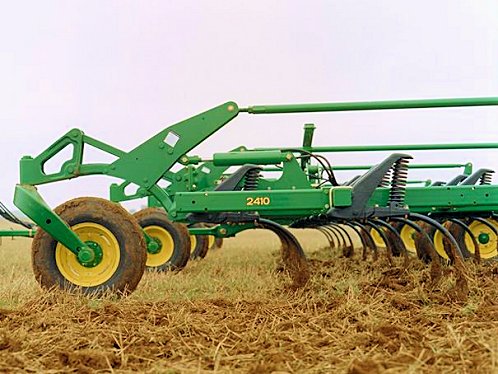

John Deere 2410 Chisel Plow.
Arizona Soil Tilling & Cultivation.
Photo Courtesy: John Deere. John Deere DH 10 Disk Harrow.
Arizona Soil Tilling & Cultivation.
Photo Courtesy: John Deere. 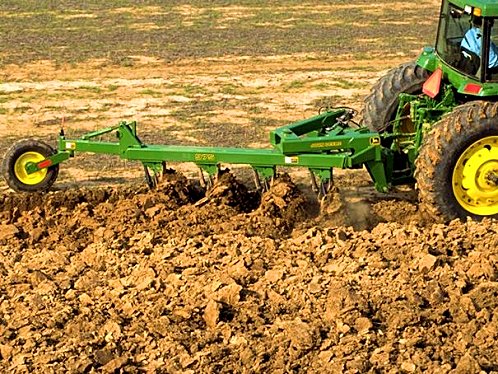
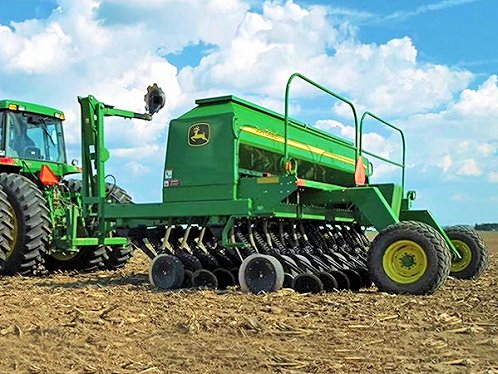
John Deere 975 Reversible Furrow Plow.
Arizona Soil Tilling & Cultivation.
Photo Courtesy: John Deere. John Deere Seed Drill.
Arizona Soil Tilling & Cultivation.
Photo Courtesy: John Deere.
The Images Shown Below, Are In Order, According To
How Farmers In Yuma, Arizona Till & Cultivate Their Fields To Produce Lettuce.
We Recommend A Similar Practice In Your Garden. Of Course, Without The Expensive Farm Equipment.
We Don't Know Of Any Vegetable Garden Plant That Would Be Harmed By This Method!
 |  |
| John Deere 2410 Chisel Plow. Arizona Soil Tilling & Cultivation. Photo Courtesy: John Deere. | John Deere DH 10 Disk Harrow. Arizona Soil Tilling & Cultivation. Photo Courtesy: John Deere. |
|---|---|
 |  |
| John Deere 975 Reversible Furrow Plow. Arizona Soil Tilling & Cultivation. Photo Courtesy: John Deere. | John Deere Seed Drill. Arizona Soil Tilling & Cultivation. Photo Courtesy: John Deere. |
The Images Shown Below, Are In Order, According To
How Farmers In Yuma, Arizona Till & Cultivate Their Fields To Produce Lettuce.
We Recommend A Similar Practice In Your Garden. Of Course, Without The Expensive Farm Equipment.
We Don't Know Of Any Vegetable Garden Plant That Would Be Harmed By This Method!
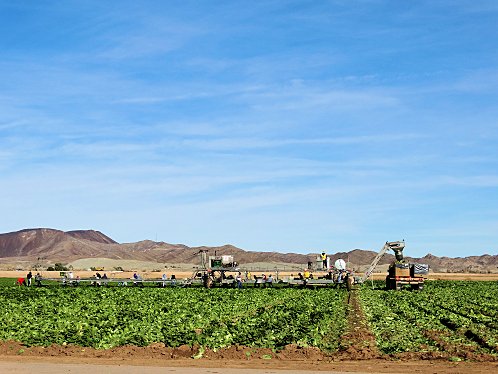 | 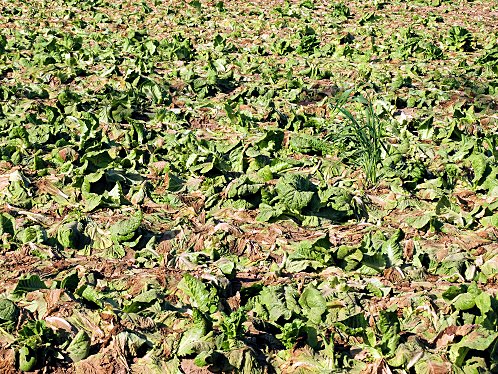 |
| The Field During The Harvesting Of The Lettuce Field. Arizona Soil Tilling & Cultivation. | The Field After The Harvesting Of The Lettuce Field. We Need To Till The Soil & Get The Organic Material Back In The Soil. Arizona Soil Tilling & Cultivation. |
|---|---|
 |  |
| First, Pre-irrigate To Facilitate Salt Leaching (movement with water below the root zone). After Soaking The Soil, & Allowing It To Dry Enough So That You Can Plow It. DO NOT PLOW IF THE SOIL IS WET! Pass A Chisel Plow Over The Field. Plow It To A Depth Of 10 - 12 Inches. Arizona Soil Tilling & Cultivation. | After The First Or Second Pass Of The Chisel Plow The Size Of The Large Soil Clumps May be About 4 - 10 Inches. Arizona Soil Tilling & Cultivation. |
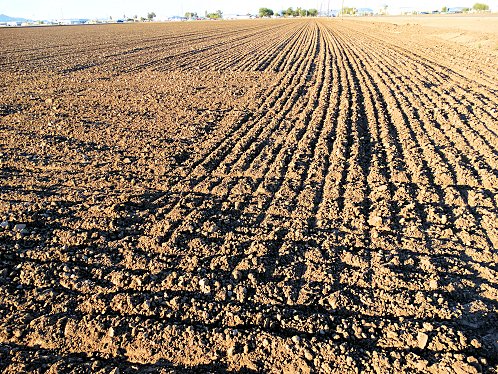 |  |
| Next, Pass A Disc Harrow Over The Field. The Field May Need Harrowing Several Times. Arizona Soil Tilling & Cultivation. | After The First Or Second Pass Of The Harrow The Size Of The Large Soil Clumps May be About 1 - 2 Inches. Arizona Soil Tilling & Cultivation. |
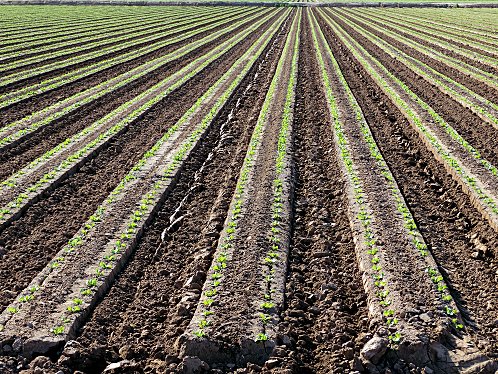 |  |
| Next, A Furrow Plow Makes The Furrows & A Seed Drill Plants The Seeds At The Desired Space & Depth. Arizona Soil Tilling & Cultivation. | Next, A Furrow Plow Makes The Furrows & A Seed Drill Plants The Seeds At The Desired Space & Depth. Arizona Soil Tilling & Cultivation. |
 | 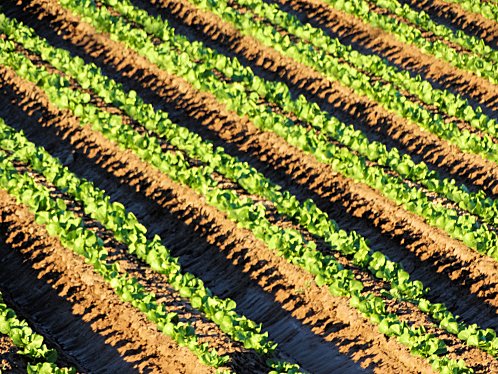 |
| Beds Are Typically 8 to 10 Inches High. Arizona Soil Tilling & Cultivation. | On 40 To 42 Inch Centers. Arizona Soil Tilling & Cultivation. |
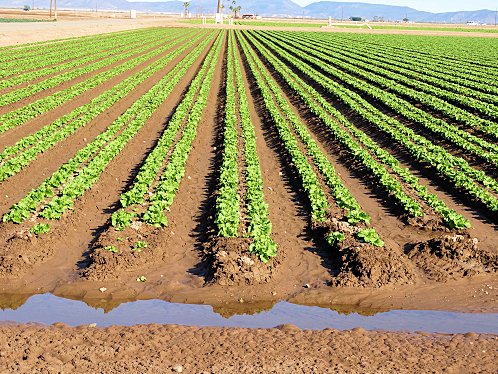 | 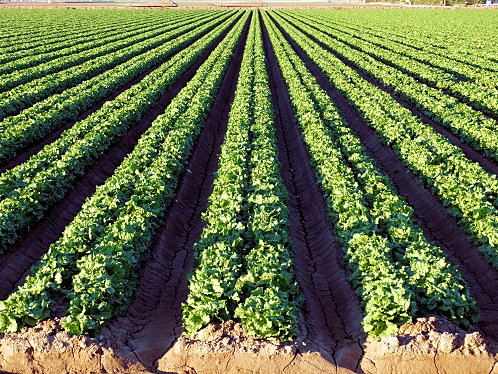 |
| Laid Out In A North-South Direction. This Orientation Minimizes Temperature & Light Differences Between The Two Rows On Each Bed. Arizona Soil Tilling & Cultivation. | Laid Out In A North-South Direction. This Orientation Minimizes Temperature & Light Differences Between The Two Rows On Each Bed. Arizona Soil Tilling & Cultivation. |
Publication About Fertilizer. You Will Leave deLange.org
We Are Proud Of Our SafeSurf Rating!
Sold Through Amazon.Com That We Recommend,
Click On The Item For A More Detailed Look. No Obligation!
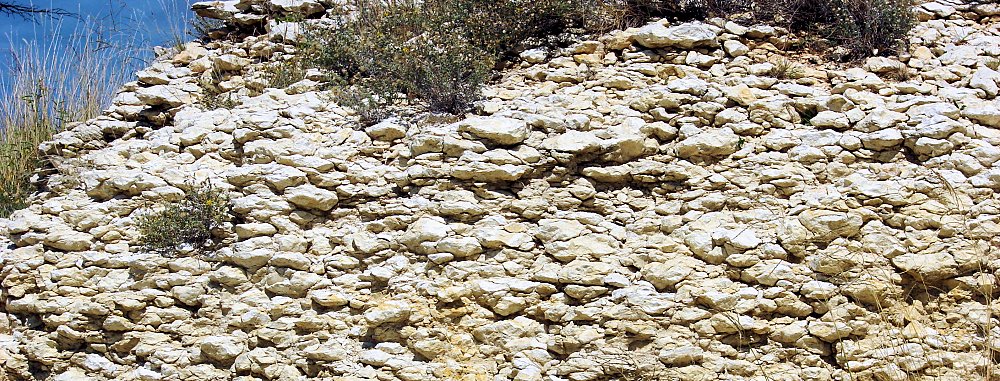 |
| Caliche. The Cause Of Numerous Failures Of Gardens, Orchards, & Landscapings. It Often Lurks Inches or Feet Beneath Your Lawn, Garden, or Orchard! Very Common In Arizona Soil!. Photo Courtesy Of: Wikipedia, the free encyclopedia. Caliche Berm Surrounding A Stock Tank In Central Texas. |
|---|
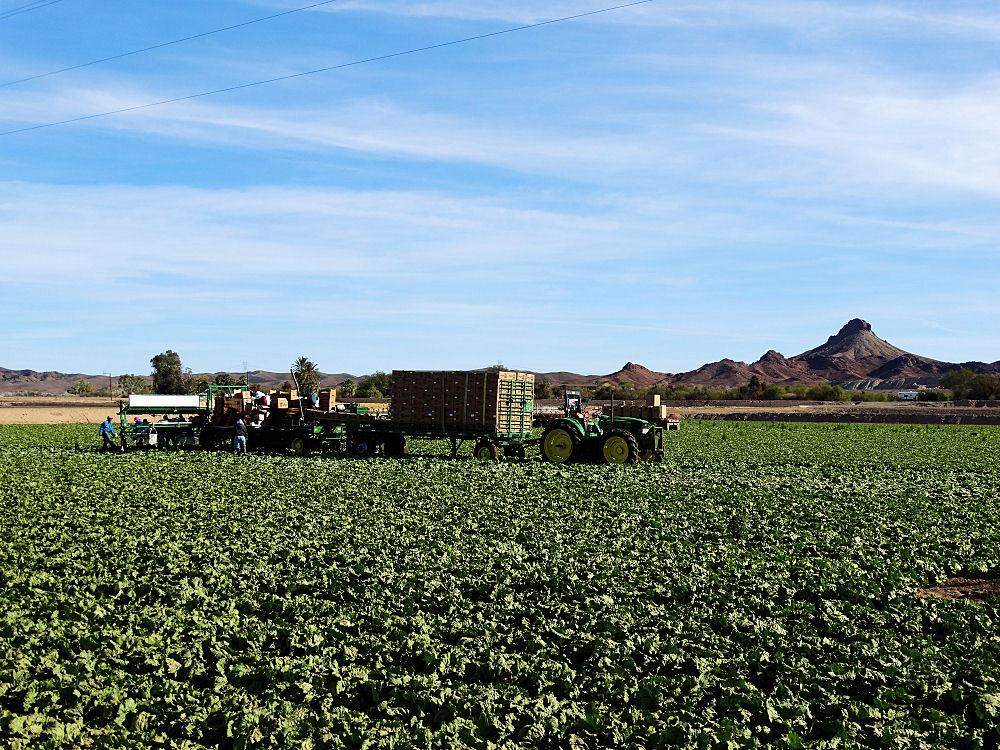 |
| People Harvesting Lettuce In On A Harvesting Machine In Yuma, Arizona. Photo Taken January 21, 2016. Click On This Photo For A Video Of People Harvesting Lettuce In Yuma, Arizona. 17.3 MB. |
|---|
We Buy Our Hard To Find Fruit Trees For Yarnell Arizona At Nature Hills Nursery.
We Have Several Nice Fruit Trees Growing In Yarnell, Arizona.
They Will Do Well In Other Similar Elevations In Arizona. ie.. Prescott, Cottonwood, Camp Verde, Sedona.
Cameo & Fuji Apples! Yummm! Click The Nature Hills Nursery Link To View.



| © 1966 - Present, George & Eve DeLange |
We're Glad You Stopped By! Come back soon!
All Of Our Images Are Copyrighted. They May Not Be Used Without Permission.
The Low Resolution Photos That Can Be Downloaded From Our Pages Are Available, Free Of Charge, Upon Request:
To Students, & Teachers For Classroom Use
Any Other Use Is Considered Commercial.
Almost All Of Our Photos (NOT ALL) Are Available In High Resolution, For Commercial Use (Books, Magazines, TV Productions, etc.)
They Are Royalty Free, And A One Time, $30 US Fee Is Charged For Each Photo
We Are Proud Of Our SafeSurf Rating!




